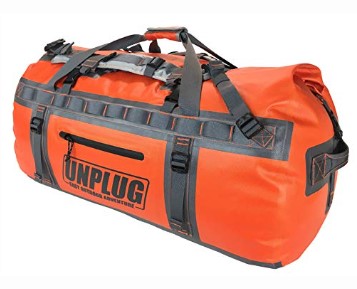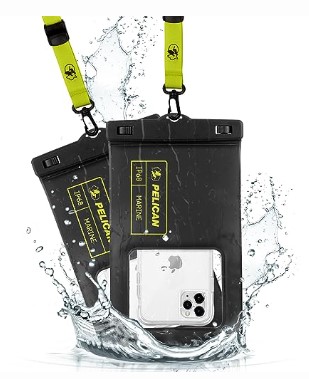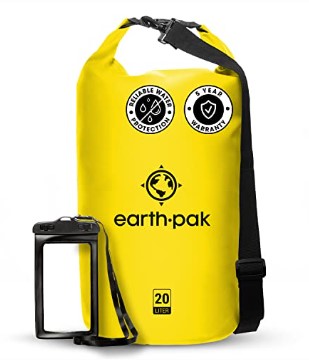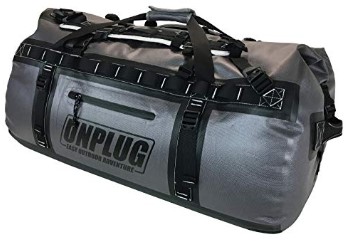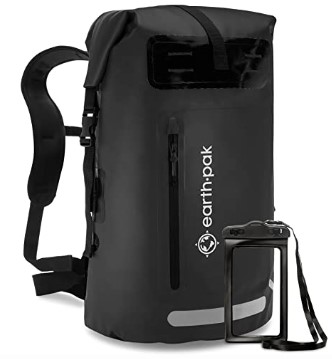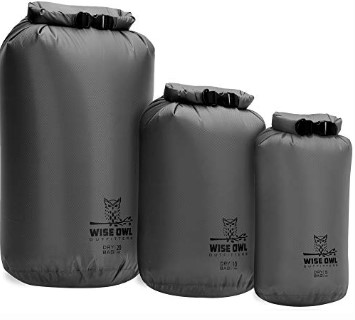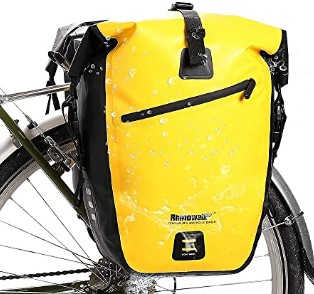If you love the outdoors, then a dry bag should be part of your essentials.
Whether you are taking a day off to go motorcycling, swimming, kayaking, or fishing, it will keep your luggage dry.
Read on to discover what is a dry bag, what you can use it for, and the various types available.
How Do Dry Bags Work?
For dry bags to work, they have an airtight closure, either with a buckle or zip.
Some designs have a roll-top that you twist to close, while others have barrel-like round shapes.
If you are going out on an adventure, choose one that suits your needs for the safety of your belongings.
What Is A Dry Bag?
Dry bags are meant to protect your luggage, especially in wet situations.
They are made from waterproof fabrics of varying densities, with some being lightweight while others are almost plastic-heavy.
Moreover, they come in various designs, shapes, sizes, and colors.
What Do You Use Dry Bags For?
No one wants to deal with wet items, especially for things you prefer dry, such as extra clothing, gadgets, and food.
Therefore, getting a dry bag to store all your luggage when going out in potentially wet conditions is necessary.
You can use it daily, especially if you cycle or ride to work. It will keep your laptop, lunch, notebooks, coat, and phone safe and dry during wet weather.
Camping, kayaking, and rafting trips also require dry bags to keep your property safe on the water.
Benefits Of Dry Bags
The main advantage of a dry bag is the waterproof protection of your valuables, which also allows you to organize your luggage.
Most types have several compartments where you can separate your belongings. You can store clothing in one pocket and then foodstuff/supplies in the rest.
Since dry bags also come in liters, similar to hiking backpacks, the different sizes allow you to pack many items.
You do not have to worry about leaving out your must-haves when traveling. Choose the largest possible sizes to save space and avoid carrying several small-size dry bags.
Tips For Choosing A Dry Bag
There are various factors to consider when choosing a dry bag for your excursions.
For instance, color choices depend on preference, but there are mandatory things to look out for.
Dry Bag Capacity
The bag size does matter, especially depending on the number of contents you need to bring.
It doesn’t have to be massive, but you are good to go as long as it fits all the essentials.
Durability
While lightweight dry bags are ideal for short day trips such as hiking, they may not last long with regular use. Instead, go for a tougher dry bag that will not peel off or tear after exposure to minimal moisture.
Material
Choose a material that will withstand all conditions depending on where you are going. Thicker ones are usually better water-resistant quality and are best for water activities.
Bag Weight
A heavy dry bag may be tedious to carry, especially on your back when hiking. Save the bulky bags for kayaks or on the back of a bicycle or motorcycle.
Types Of Dry Bags
If you want a dry bag for your next trip, here are the best ones to purchase.
Each bag may look different in design but serves a similar purpose.
Motorcycle Dry Bags
If you own a motorcycle, get a dry bag that will sit well at the back or on the sides while holding all your gear.
Since they are meant to withstand harsh winds and rain when on the move, their material quality is also high.
Try the UNPLUG waterproof bag with compression straps to safely hold all your gear. It is heavy-duty for all outdoor activities all year round.
Phone Case Dry Bags
We carry our mobile phones to the beach, especially when taking boat rides, and phone dry bags protect them.
These bags have a transparent cover from which you can still use your phone and take photographs.
The Pelican 2 Pack Marine phone case is perfect for your iPhone when swimming or going to the beach. You can have the detachable lanyard around your neck or remove it if you would rather carry it inside another dry bag.
Kayaking Dry Bags
Going out to sea or water on a kayak is an extreme activity prone to wetness, and you will need a dry bag for your extra supplies.
Most kayak dry bags are cylindrical, with straps you can tie down during turbulence.
The Earth Pak kayaking dry bag is made of PVC with a snap closure. It is lightweight, and the shoulder strap makes carrying it easy.
Furthermore, you can use the double-sided transparent and waterproof phone case that comes with it on the water.
Dry Holdalls
These dry bags have a wider opening on the top, making access easy. However, they are not ideal for immersion, as the closure allows seepage.
Nevertheless, they are large and will hold more compared to roll tops. If you purchase the UNPLUG tactical duffle bag, it is massive enough for all your travel gear.
Rucksacks
Like a backpack, you can carry dry rucksacks for a hiking trip. They come in different sizes, and in case of rain, your belongings remain dry.
Should you go kayaking, strap them onto your back and have your hands free for rowing. The Earth Pak Backpack sits comfortably on your back and is ideal for campers and outdoor enthusiasts.
Barrel Roll Tops
As the most popular type of dry bag, barrel roll tops are round with a top closure. Any seams on the bags are tightly sewn to keep them waterproof.
To fill them, you hold them upright and roll the opening closed. Two clasps on the top keep the rolled end in place. Get the Wise Owl Outfitters dry bags that are fully submersible and airtight.
Cycling Dry Bags
A dry bag is common and essential for cyclists. You can place it on the back or tie it to the handlebars.
Whether cycling to work or cross country, your items will remain dry, especially in spring and fall.
As one of the best cycling dry bags, the Rhinowalk Pannier Rack bag will withstand all weather conditions. It is also bright enough to act as an extra reflector.
How To Pack A Dry Bag
If it is your first time using a barrel roll top dry bag, the below process should help you pack it effortlessly.
First, ensure you have the right size and fold your clothes, if any, that you want to put into the dry bag.
Step 1
Open up the bag and hold it upright. If you are placing it inside another bag, ensure it fits well.
Step 2
Pack your belongings in the same manner you would pack a backpack. The rolling clothes method always saves space, so use it. Ensure you pack based on priority, with the heavier less likely to use items at the bottom. Avoid sharp items that may pierce the bag.
Step 3
Once your entire luggage fits, it is time to close up the bag. For dry bags, leaving a gap at the top is a must. The leftover bag space is what we will use to roll up and ensure the bag is waterproof. If you will be on water, leave enough air space in the bag to enable it to float.
Step 4
The last thing to do is to attach the two buckles, and your bag is ready for your adventure.
Read now
Frequently Asked Questions
What do you put in a dry bag?
If you want to take anything with you, you can put it in a dry bag and keep it dry or safe.
Besides clothes, you can put toiletries, a hat, a tea or coffee flask, snacks, and a bottle of water. It all depends on your trip or excursion, whether on land or water.
Do dry bags float?
Yes. While some bags may not stay long on water, most will float if you leave some air in when packing. You should also ensure the top closure is well sealed to prevent water from seeping in.
However, long exposure to water may result in seepage whether you submerge them in deep or shallow water.
Can you put wet clothes in a dry bag?
Yes, you can. If you are going outdoors or kayaking, consider having two dry bags, one for your wet clothes and another for the dry ones.
You also do not want to mix dirty things with clean items, as they may become smelly or stained.
What is the difference between a dry bag and a waterproof bag?
A dry bag will prevent its contents from getting wet should it accidentally fall in water for a few seconds.
On the other hand, a waterproof bag has a tight seal that will prevent water seepage for an extended period.
Final thoughts
Although dry bags keep your items moisture-free, they are not 100% waterproof. If you submerge them in water for a long time, they may soak through the closure.
Ensure you read and follow the manufacturer’s instructions for use. Furthermore, check if the material will not absorb water quickly, especially in wet conditions or areas.
- The Secret Travel Locations Bloggers Haven’t Discovered Yet
- Stress-Free Breaks: Choosing the Perfect Getaway for Overworked Professionals
- Inside Secrets: The Quick Guide to Planning Your Dream Vacation
- Hidden Gems vs Tourist Spots: Saving Pounds on Your Next Vacation
- Master the Art of Travel Thrifting: Tips from the Pros
- Travel Like a Spy: Secret Skills for Safe Adventuring

